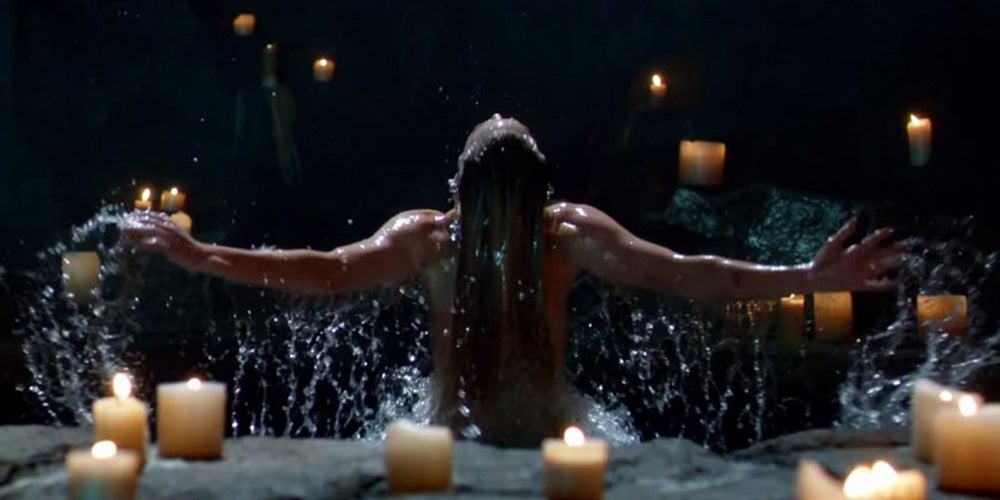At one point in Patty Jenkins’s Wonder Woman, Steve Trevor washes himself in the restorative waters of a Themysciran cave — but just how restorative were they, and could they be tied to the Lazarus Pits?
Videos by ComicBook.com
It is difficult to know, and likely any connection to the Pits will not be made overt, but it seemed worth at least asking since, despite dozens of fan theories covering a wide variety of ground, we had not see anyone speculating about whether or not the springs at Themyscira could be tied to the Lazarus Pit.
While the pit does not appear to heal Steve Trevor’s wounds, it appears to be some kind of mystical water from a glowing source, and Trevor himself is feeling pretty good and giggly when the film joins him in the bath.
Could that have been evidence that the bathing hole was having some kind of physiological or psychological effect on him? Or was he just enjoying moments of peace amid a lengthy and demoralizing war?
And if it was having some kind of impact on him, could that mean something more for the future of DC’s movies and the mythology of Ra’s al Ghul’s Lazarus Pits?
What is the Lazarus Pit?
In the comics, Lazarus Pits are a naturally-occuring phenomenon in the DC Universe; think of it as a natural spring with restorative powers. Very restorative. They can help cure and heal those at death’s door, or keep a healthy person young seemingly indefinitely. For centuries, the pits served the purpose of prolonging the lives of Ra’s al Ghul and those closest to him.
While the borderline-supernatural nature of the Pits had kept them largely absent from previously live-action incarnations of Batman and related characters, their increasingly frequent use in live action TV coupled with a DC Extended Universe in which Batman and his rogues coexist with metahumans, aliens, and other extranormal phenomena certainly suggests that using them in the DCEU is not out of the question.
A number of other characters besides Ra’s al Ghul have taken a dip in the pits to be healed, including Batman. At one point, Ra’s claimed that the pits could even restore those long dead, stealing the bodies of Thomas and Martha Wayne and threatening to bring them back to life. In most cases, the Lazarus Pit has a corrosive influence on the user’s mental health, particularly if used over a long period of time.
Lazarus Pits are composed of a unique unknown chemical blend that bubbles up somewhere within the Earth’s crust to the surface at key points on Earth, typically at the junction of ley lines. Besides the Pits themselves, there are other ways to tap the “waters” and get their benefits in the comics.
The pit has also made the jump to various other media, including animation (Batman: The Animated Series and Batman Beyond) and video games (Batman: Arkham City). After those successes, it finally made the jump to live action…

In the Arrowverse
On Arrow, the pit was teased for a while before it was clearly named — and once it was, we learned that its effects were finally starting to wear off and that Ra’s al Ghul was dying.
This is why he needed an heir, a role for which he chose Oliver Queen. In the comics, he just kinda…wants one…and that “honor” goes typically to Batman.
Anyway, after Ra’s there have been a number of people who were healed or revived by the Pit, most notably Thea Queen and Sara Lance. In Sara’s case, she had been dead for months and after she came back, her body was essentially feral and disconnected from her soul, which John Constantine had to retrieve.
Furious at its use and despondent that her soulmate had been corrupted by her father (by extension) one last time, Ra’s al Ghul’s daughter Nyssa Raatko destroyed the Pits — something that makes a lot more sense when you consider that, like Solomon Grundy, the Lazarus Pits were Batman properties used in Arrow and then returned to Gotham.

Gotham and the movies
At the end of last season, the Lazarus Pit made a brief-but-important appearance on Gotham.
After being brainwashed by Ra’s al Ghul, Bruce put a sword through Alfred’s chest — an action so jarring that it lifted the veil around Bruce’s mind and restored him to his normal self. Alfred, who had been willing to sacrifice himself because he had faith that the “real” Bruce would eventually resurface, did not die, though: he was revived by the waters of the Pit, which Bruce used to keep him hanging on long enough to get proper medical attention.
The roots of the Pit are not particularly explored in Gotham, but of course astute fans can suss out just what happened and even absent a convoluted mythology, context within the episode tells the audience that there is something “special” or “magical” about the waters.
In addition to the Pits’ regenerative uses, their power has also been used as a weapon in the comics . When Ra’s al Ghul’s daughter Nyssa once confronted the Injustice Society, she claimed to have a staff which channeled the power of the Pits and could therefore destroy both the undead Solomon Grundy and Gentleman Ghost. That is an interesting element to introduce on Gotham, just as Solomon Grundy is coming to the show.
The decision to bring the Lazarus Pit into Batman’s story so early — before he was even Batman — is an odd, interesting choice, and potentially one that suggests just how significant Ra’s and the Pit are considered to be in Batman’s mythology.
Does that inherently mean that the Pits will appear in Matt Reeves’ The Batman or other, related movies? Not as such, no. Certainly it does not guarantee any ties to the waters spotted in Wonder Woman — but when it comes to live-action adaptations of shared-universe stories, writers and producers certainly like to give their heroes and villains shared origins.
Think of The CW’s The Flash, where it seems each new season introduces an event from which all of the villains flow. Hell, even in the comics, Geoff Johns introduced the various Lantern Corps and then gave them a kind of shared origin/mythology that bound them together and attempted to explain why the rings all functioned differently.









